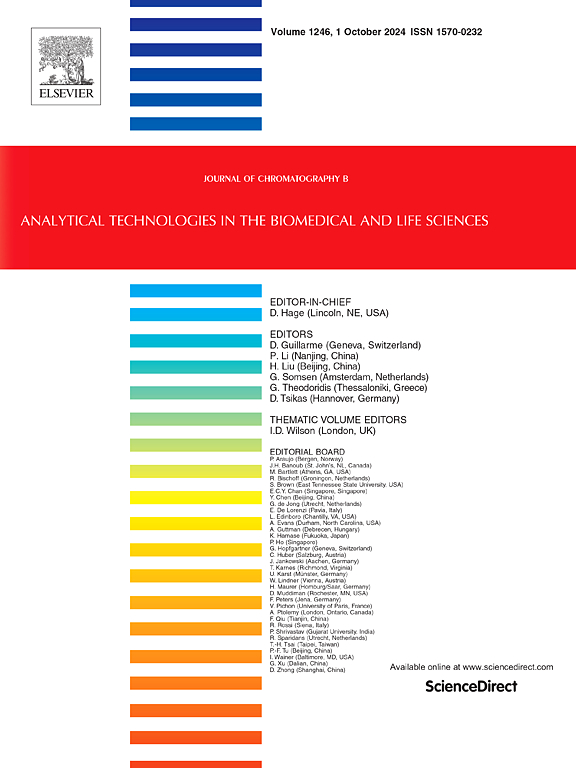高效阴离子交换色谱-脉冲安培检测法定量残留DTT
IF 2.8
3区 医学
Q2 BIOCHEMICAL RESEARCH METHODS
引用次数: 0
摘要
与减毒活疫苗或灭活病毒疫苗相比,VLP(病毒样颗粒)已被证明是更安全的候选疫苗。作为基于vlp的疫苗生产过程的一部分,二硫苏糖醇(DTT)和其他还原剂通常用于vlp的拆卸,随后进行重新组装过程以去除添加的还原剂。这种拆卸和重组过程提高了VLP的完整性、稳定性和免疫反应性。在制造VLPs时,必须确保去除DTT,因为它是一种剧毒物质。残余DTT含量必须在最终药品的整个生产流程中进行监测。现有的估计DTT的方法涉及化学衍生,这是复杂的,可能需要100%衍生低水平的DTT。在这项研究中,我们报道了一种基于HPAEC-PAD和电化学检测器相结合的简单、新颖、灵敏的DTT定量方法。该方法的线性范围为1 ~ 10 ng/mL,定量限为100 pg。在检测病毒和vlp疫苗中残留DTT方面,该方法比现有的荧光和hplc - ms方法更具成本效益和灵敏度。该方法可用于监测使用DTT作为工艺试剂的任何疫苗或产品中的残留DTT水平。本文章由计算机程序翻译,如有差异,请以英文原文为准。
Quantification of residual DTT by high-performance anion-exchange chromatography coupled with pulsed amperometric detection
VLP (virus-like particle) have proven to be safer vaccine candidates compared to live-attenuated or inactivated viral vaccines. As part of the manufacturing process of VLP-based vaccines, dithiothreitol (DTT) and other reducing agents are commonly used in the disassembly of VLPs, followed by a subsequent reassembly process for the removal of the added reducing agents. This disassembly and reassembly processes improve VLP integrity, stability and immunoreactivity. In the manufacture of VLPs, it is essential that DTT removal is ensured since it is a highly toxic substance. Residual DTT content has to be monitored throughout the manufacturing process flow of the final pharmaceutical product. The available method for DTT estimation involves chemical derivatization which is complex and may require 100 % derivatization of low levels of DTT. In this study, we report a simple, novel and sensitive method for DTT quantification based on the combination of HPAEC-PAD and an electrochemical detector. The developed method has a linear range from 1 to 10 ng/mL with a limit of quantification of 100 pg. It is cost-effective and more sensitive than current available fluorescent and HPLC-MS-based methods for detecting residual DTT in viral and VLP-based vaccines. This method can be implemented to monitor residual DTT levels in any vaccine or product where DTT is used as a process reagent.
求助全文
通过发布文献求助,成功后即可免费获取论文全文。
去求助
来源期刊

Journal of Chromatography B
医学-分析化学
CiteScore
5.60
自引率
3.30%
发文量
306
审稿时长
44 days
期刊介绍:
The Journal of Chromatography B publishes papers on developments in separation science relevant to biology and biomedical research including both fundamental advances and applications. Analytical techniques which may be considered include the various facets of chromatography, electrophoresis and related methods, affinity and immunoaffinity-based methodologies, hyphenated and other multi-dimensional techniques, and microanalytical approaches. The journal also considers articles reporting developments in sample preparation, detection techniques including mass spectrometry, and data handling and analysis.
Developments related to preparative separations for the isolation and purification of components of biological systems may be published, including chromatographic and electrophoretic methods, affinity separations, field flow fractionation and other preparative approaches.
Applications to the analysis of biological systems and samples will be considered when the analytical science contains a significant element of novelty, e.g. a new approach to the separation of a compound, novel combination of analytical techniques, or significantly improved analytical performance.
 求助内容:
求助内容: 应助结果提醒方式:
应助结果提醒方式:


